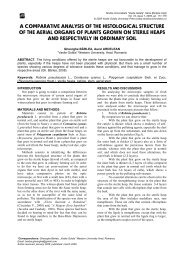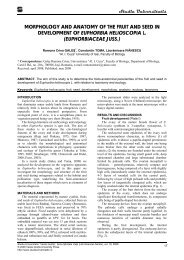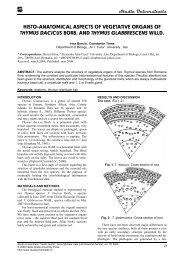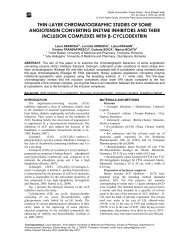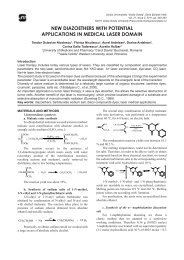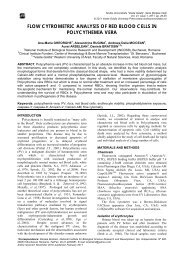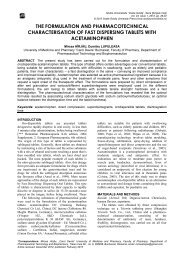Read full article - Studia Universitatis Vasile Goldis, Seria Stiintele ...
Read full article - Studia Universitatis Vasile Goldis, Seria Stiintele ...
Read full article - Studia Universitatis Vasile Goldis, Seria Stiintele ...
Create successful ePaper yourself
Turn your PDF publications into a flip-book with our unique Google optimized e-Paper software.
<strong>Studia</strong> <strong>Universitatis</strong> “<strong>Vasile</strong> Goldiş”, <strong>Seria</strong> Ştiinţele Vieţii<br />
Vol. 19, issue 2, 2009, pp.283-286<br />
© 2009 <strong>Vasile</strong> <strong>Goldis</strong> University Press (www.studiauniversitatis.ro)<br />
HISTOANATOMY OF ECHINODORUS CORDIFOLIUS (L.)<br />
GRISEB. (ALISMATACEAE)<br />
Rodica BERCU<br />
Faculty of Natural and Agricultural Sciences, “Ovidius” University, Constanta, Romania<br />
ABSTRACT. The <strong>article</strong> comprises investigation of the adventitious root, rhizome and leaf anatomy of an<br />
aquatic perennial herb Echinodorus cordifolius (L.) Griseb. (sin. E. radicans (Nuttall) Engel. Alisma cordifolia<br />
L.). The origin of this species is from the wetlands (marshes, swamps and ponds) in Mexico and North<br />
America, over Caribian Islands but widespread from Venezuela to Columbia. This species belongs to<br />
Alismataceae family, living mostly amphibious (roots, rhizome and leaf petiole). The leaves are emersed,<br />
rarely submersed. The flowers are 25 mm wide and have white petals. There are clustered in racemes of 3-<br />
15 flowers. The fruit is a plump. The anatomical characteristics of Echinodorus cordifolius vegetative organs<br />
has been described and discussed. In the literature a study into the anatomy of this species almost lack,<br />
excepting some systematic studies on this plant.<br />
Keywords: anatomy, root, stem, blade, Echinodorus cordifolium<br />
INTRODUCTION<br />
Echinodorus cordifolius (L.) Griseb. belongs to the<br />
large Alismataceae family, is an aquatic plant, living<br />
mostly amphibious. It is a perennial herb found in<br />
wetlands, occasionally it may be found in the marshes,<br />
swamps and ponds (Cook, 1985; Wikipedia free<br />
encyclopedia). The leaves have petioles up to 80 cm<br />
and the middle green blades have a broad oval form<br />
and 7 to 9 veins leave the base. The submerged leaves<br />
can be spotted red-brown. Echinodorus cordifolius<br />
blade has a cordate base (therefore the name) and<br />
pellucid markings as short lines (Wunderlin, 1998).<br />
The flowers are clustered in racemes of 3-15 flowers,<br />
appearing in long day periods growing up to 120 cm<br />
from the base to the first whorl. Each flower is 25 mm<br />
wide and has white petals. First of all the inflorescence<br />
is growing erect, but soon lay down by his mass and<br />
then creeping above the ground. The fruit is a plump.<br />
Adventitious plants are soon appearing at the whorls<br />
and can be used for propagation. Echinodorus<br />
cordifolium is recommended only for large aquariums<br />
trade (Haynes and Holm-Nielsen, 1994; Muhleberg,<br />
1982). Our purposes were to show some features of<br />
anatomical interest concerning Echinodorus cordifolius<br />
root, stem and the sessile leaf, in accordance with it<br />
hydrophytic habit.<br />
MATERIALS AND METHODS<br />
The plant was collected from the faculty laboratory<br />
aquarium. Small pieces of the adventitious root,<br />
rhizome and leaf were fixed in FAA (formalin:glaciar<br />
acetic acid:alcohol 5:5:90). Cross sections of the<br />
vegetative organs were performed using the classical<br />
technique used in vegetal histology (Bercu, Jianu,<br />
2003). The samples were stained with alum-carmine<br />
and iodine green. Histological observations and<br />
micrographs were performed with a BIOROM –T<br />
bright field microscope, equipped with a TOPICA<br />
6001A video camera. The microphotographs were<br />
obtained from the video camera through a computer.<br />
RESULTS AND DISCUSSIONS<br />
Cross section of the advetitious root reveals the<br />
following features. Epidermis, the outermost layer is<br />
composed of simple barrel-shaped cells. Hairs are<br />
absent. The cortex is well developed and rough<br />
differentiated into 3 distinct zones. The outer cortex<br />
consist compactly arranged parenchymatous cells. The<br />
middle cortex is well developed and covers the major<br />
portion of the root. It is composed of large number of<br />
conspicuous air chambers, which are separated from<br />
each other by uniseriate partitions - trabeculae<br />
(Batanouny, 1992). The air chambers are developed<br />
schzogenously (Bavaru, Bercu, 2002; Bouman,<br />
Houtuesen, 1996) (Fig. 1A, B). The inner cortex<br />
consists of 3-4 layers of parenchymatous cells,<br />
enclosing intercellular spaces. The cells are nearly<br />
spherical in shape and regularly arranged in concentric<br />
layers. Characteristically, the endodermis is onelayered,<br />
possessing U-shaped lignified cells alternating,<br />
at places, with pericycle cells.<br />
The stele is enclosed by a single layered pericycle.<br />
The vascular bundles are of radial type and more than<br />
four in number. The xylem shows exarch condition,<br />
metaxylem towards the centre and protoxylem facing<br />
the periphery. Phloem is well developed and present<br />
among the xylem groups (Fig. 2).<br />
*Correspondence: Bercu R., Universitatea “Ovidius” Constanţa, Facultatea de Ştiinţe ale Naturii şi Ştiinţe Agricole, Departamentul de<br />
Botanică, B-dul Mamaia nr.124, 900572, Constanţa, Romania, e-mail: rodicabercu@yahoo.com<br />
Article received: August 2009; published: November 2009
Bercu R.<br />
Fig. 1 Cross section of the root. Portion with epidermis and acernchyma (A). The schizogenous formation of an air<br />
chamber (B): AC- air chamber, Ex- exodermis, R- rhizodermis, T- trabeculae (orig.)<br />
Fig. 2 Portion of the root’s stele: Ed- endodermis, Exexodermis,<br />
IC- inner cortex, Pc- pericycle, Ph- phloem,<br />
X- xylem (orig.)<br />
Cross section of the petiole reveals the following<br />
anatomical characteristics. Epidermis is one-layered<br />
with thin-walled cells. The cortex lies beneath the<br />
epidermis and is differentiated in two distinct zones.<br />
The sub-epidermal region (hypodermis) is composed of<br />
thin walled compactly arranged parenchymatous cells,<br />
whereas the inner region is made up of symmetrically<br />
arranged air spaces separated by thin partitions made<br />
up of a single layer of thin-walled cells. Rare small<br />
insignificant vascular bundles occur (Fig. 3; 4, A).<br />
Such as other aquatic plants, rests of diaphragmatic<br />
tissue are present (Bercu, 2004). Epidermis and<br />
hypodermis contain abundant chloroplasts (Fig. 4, B).<br />
Fig. 3 Cross section of the petiole. Portion of aerenchyma<br />
and vascular bundles: AC- air chamber, E- epidermis, H-<br />
hypodermis, VB- vascular bundle (orig.)<br />
284<br />
Fig. 4. Cross sections of the petiole. Portion with<br />
epidermis and cortex (A). AC- air chamber, BS- bundle<br />
sheath, Chl- chloroplasts, DT- diaphragmatic tissue, Mxmetaxylem,<br />
Ph- phloem, PxL- protoxylem lacuna (orig.)<br />
<strong>Studia</strong> <strong>Universitatis</strong> “<strong>Vasile</strong> Goldiş”, <strong>Seria</strong> Ştiinţele Vieţii<br />
Vol. 19, issue 2, 2009, pp. 283-286<br />
© 2009 <strong>Vasile</strong> <strong>Goldis</strong> University Press (www.studiauniversitatis.ro)
Histoanatomy of Echinodorus cordifolius (L.)<br />
Griseb. (Alismataceae)<br />
Fig. 4. Cross sections of the petiole. Aerenchyma with<br />
diaphragmatic tissue (B). AC- air chamber, BS- bundle<br />
sheath, Chl- chloroplasts, DT- diaphragmatic tissue, Mxmetaxylem,<br />
Ph- phloem, PxL- protoxylem lacuna (orig.)<br />
Fig. 4. Cross sections of the petiole. A large vascular<br />
bundle (C): AC- air chamber, BS- bundle sheath, Chlchloroplasts,<br />
DT- diaphragmatic tissue, Mx- metaxylem,<br />
Ph- phloem, PxL- protoxylem lacuna (orig.)<br />
The stele is represented by a centrally located large<br />
vascular bundle with few xylem and phloem elements.<br />
The central vascular bundle consists of metaxylem<br />
vessels and a protoxylem lacuna. Phloem possesses<br />
sieve vessels, companion cells and few phloem<br />
parenchymas (Fig. 4, C). The endodermis and pericycle<br />
are absent and the protection of the vascular tissue is<br />
afforded by a parenchymatous cells surrounding them<br />
(Fig. 4, A, C).<br />
A transversal section through the blade exhibits the<br />
usually succession of tissues. The upper epidermis such<br />
as the lower one forms a single layer of thin-walled<br />
cells. The upper epidermis forms a crest below the<br />
large veins. The mesophyll is undifferentiated<br />
consisting large thin walled-cells interrupted by two<br />
large air chambers placed both sides of each large vein<br />
and homogenous to the margins (Fig. 5 A and C).<br />
However the cells, placed just below the upper<br />
epidermis remember a palisade tissue, consisting<br />
abundant chloroplasts whereas the rest layers of cells<br />
few.<br />
The vascular system of a large vein is represented<br />
by xylem and phloem. Remarkable are the vascular<br />
bundles of the vein with primary structure forming a<br />
crest to the lower epidermis. Xylem is placed to the<br />
upper epidermis and phloem to the lower one. Each<br />
vascular bundle is protected by a parenchymatous<br />
sheath (Fig. 5 B and C).<br />
CONCLUSIONS<br />
Results revealed that the root of Echinodorus<br />
cordifolius possesses a typical primary structure.<br />
However, the cortex is well-developed, containing a<br />
large number of air chambers and the stele is<br />
characteristic to monocots roots. The leaf petiole<br />
epidermis is thin-walled, lacking cuticle. The cortex<br />
possesses air chambers and a number of small close<br />
collateral vascular bundles embedded in the aquatic<br />
parenchyma tissue. Phloem is prominent and located in<br />
the outer region of the bundle, whereas xylem<br />
frequently consists a large protoxylem lacuna. Few air<br />
chambers consists rests of diaphragmatic tissue. The<br />
mesophyll possesses air chambers near by the large<br />
veins and poor developed vascular bundles. Among the<br />
veins and to the margins, the mesophyll is<br />
homogenous. Mechanical tissues are absent. The histoanatomical<br />
features of the plant organs are in<br />
accordance with it hydrophytic nature.<br />
<strong>Studia</strong> <strong>Universitatis</strong> “<strong>Vasile</strong> Goldiş”, <strong>Seria</strong> Ştiinţele Vieţii<br />
Vol. 19, issue 2, 2009, pp.283-286<br />
© 2009 <strong>Vasile</strong> <strong>Goldis</strong> University Press (www.studiauniversitatis.ro)<br />
285
Bercu R.<br />
Fig. 5 Cross section of the blade. Portion of the mesophyll (A). A vein’s small vascular bundle (B). The vascular bundle of a<br />
large vein (C): AC- air chamber, BS- bindle sheath, LE- lower epidermis, Ms- mesophyll, Ph- phloem, UE- upper epidermis, V-<br />
small vein, VB- vascular bundle, X- xylem (orig)<br />
REFERENCES<br />
Bavaru, A, Bercu, R, Anatomia şi morfologia plantelor,<br />
Ex Ponto, Constanţa, 2002<br />
Batanouny, KH, Plant Anatomy, Cairo University<br />
Press, Cairo, 1992<br />
Bercu R, Jianu, DL, Practicum de morfologia şi<br />
anatomia plantelor, “Ovidius” University Press,<br />
Constanţa, 2003<br />
Bercu R, 2004, Histoanatomy of the leaves of Trapa<br />
natans L. (Trapaceae), Phytol Balcan., 10(1):<br />
51-55<br />
Bouman F, Houtuesen J., 1996, Strukturele botanie. 2.<br />
Weefsels, CD-ROM Versie, SEP, Hugo de<br />
Vries laboratorium<br />
Cook CDK, 1985, Range Extensions of Aquatic<br />
Vascular Plant Species. J. of Aquatic Plant<br />
Managemen, 23: 1-6.<br />
Haynes RR, Holm-Nielsen LB, 1994, The<br />
Alismataceae, Flora Neotropica, New York<br />
Botanical Garden, New York<br />
Muhleberg H, 1982, The Complete Guide to Water<br />
Plants, Ed. EP Publishing Ltd., Germany<br />
286<br />
Wunderlin RP, 1998, Guide to the Vascular Plants of<br />
Florida. University Press of Florida<br />
Wikipedia free encyclopedia<br />
/http://en.wikipedia.org/wiki/.Echinodorus_cord<br />
ifolius<br />
<strong>Studia</strong> <strong>Universitatis</strong> “<strong>Vasile</strong> Goldiş”, <strong>Seria</strong> Ştiinţele Vieţii<br />
Vol. 19, issue 2, 2009, pp. 283-286<br />
© 2009 <strong>Vasile</strong> <strong>Goldis</strong> University Press (www.studiauniversitatis.ro)



